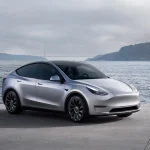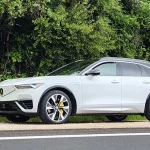
Will Jaguar Have the First Hybrid Born From Jet Turbines?Will Jaguar Have the First Hybrid Born From Jet Turbines?
“Born From Jets” may be the slogan of recently-saved-from-death Swedish Saab, but one day it may prove more appropriate for British carmaker Jaguar.
The company has been awarded funding from the U.K. government to develop a small jet turbine as a range extender for a future hybrid luxury car.
Its just-launched new 2011 Jaguar XJ full-size luxury sedan could gain an extended-range electric model within a few years that might provide a platform for the innovative jet-powered range extender.
Rover JET1 turbine-powered car concept
Bladon Jets micro turbine
1963 Chrysler Turbine concept car, photographed by Wikipedia user Karmann
Capstone Turbine CMT-380 concept car
JET1: World’s first turbine car
Rover Cars, which developed JET1, the first-ever jet-powered turbine car, is one of the predecessor companies of Jaguar Land Rover, now owned by India’s Tata Motors.
That car, now housed in London’s Science Museum, ran on gasoline, diesel, or kerosene at speeds up to 88 miles per hour. It also spawned a Le Mans racer developed with BRM Formula One that averaged more than 100 mph and topped out at 142 mph.
Smaller, lighter, less CO2
The British government awarded $1.8 million in development funds to develop the turbine-based range extender for electric vehicles to a consortium of Jaguar-Land Rover, Bladon Jets, and SR Drives.
The group says a modern micro-turbine saves more than 200 pounds over a gasoline engine for onboard power generation to recharge an electric car’s battery pack, while slightly reducing CO2 emissions.
The Bladon Jets turbine has just 5 percent of the weight and parts count of a typical four-cylinder engine.
Not so good for direct drive
As Chrysler learned a decade later, when it released 56 prototypes of its elegant Chrysler Turbine coupe for real-world tests by roughly 200 drivers, turbine technology proved too inefficient and expensive for production-car use.
Chrysler’s test cars suffered from throttle lag, lack of low-end torque, very high exhaust temperatures, and mediocre fuel economy (17 mpg) from their 97-kilowatt (130-horsepower) turbine engines, which powered the car through a standard automatic transmission.
Turbines also aren’t particularly suited to the rapid acceleration cycles of varied driving. Using a turbine as a steady-speed source to generate electric power, on the other hand, lets it operate most efficiently and at close to its maximum output.
Jaguar-Lotus “LimoGreen” project
We’ve covered the Jaguar “LimoGreen” research project before, a 2008 research project also funded by the U.K. to develop a full-size executive luxury sedan with CO2 emissions of just 120 grams per kilometer, or roughly the level of a European diesel subcompact.
That vehicle was expected to use a series hybrid powertrain, along the same principles as the 2011 Chevrolet Volt, made up of a lithium-ion battery pack, an advanced electric motor, and a compact “auxiliary power unit” (an engine that drives a generator) to be provided by Lotus.
Turbine vs. tiny engine
In September, Lotus unveiled a tiny three-cylinder, 1.2-liter Range Extender engine-and-generator set at the Frankfurt Auto Show. The Limo-Green project is covered (briefly, on pp 9-10) in a recent Lotus Engineering newsletter, covering the new dedicated hybrid and electric vehicle group within the Lotus Engineering consultancy.
But a turbine range extender adds another facet to the notion of a future electric-drive Jaguar. Compared to any combustion engine, a turbine is smoother and quieter–both prized qualities for the British brand’s luxury cars.
It’s not the very first extended-range electric vehicle with a turbine; that honor may belong to the Capstone Turbine CMT-380 concept, a supercar prototype shown at last month’s Los Angeles Auto Show.
[Bladon Jets via Motor Authority]
View original article at: “https://www.greencarreports.com//news/1042108_will-jaguar-have-the-first-hybrid-born-from-jet-turbines”
Add a comment Cancel reply
Comments (0)
รับทำ SEO
… [Trackback]
[…] Find More Information here on that Topic: autoseu.com/will-jaguar-have-the-first-hybrid-born-from-jet-turbineswill-jaguar-have-the-first-hybrid-born-from-jet-turbines/ […]
important site
… [Trackback]
[…] Information to that Topic: autoseu.com/will-jaguar-have-the-first-hybrid-born-from-jet-turbineswill-jaguar-have-the-first-hybrid-born-from-jet-turbines/ […]
crumpets disposable
… [Trackback]
[…] Find More here to that Topic: autoseu.com/will-jaguar-have-the-first-hybrid-born-from-jet-turbineswill-jaguar-have-the-first-hybrid-born-from-jet-turbines/ […]
Categories
- Activism (1)
- Adventure (1)
- Advertising (2)
- Agriculture (1)
- Air pollution (4)
- Air transport (3)
- aluminium (2)
- Amazon (3)
- Animals (1)
- Apple (2)
- Architecture (1)
- Arctic (1)
- Artificial intelligence (1)
- Augmented Reality (1)
- Auto Detailing (1)
- autopilot (1)
- battery (31)
- Best summer holiday destinations 2022 (1)
- Bicycle (1)
- biodiversity (1)
- BMW (2)
- boat (1)
- Bus (1)
- Business (4)
- Buying Guides (1)
- car (7)
- Car industry (18)
- Car News (18)
- car rental (3)
- Car Reviews (4)
- Car sales (6)
- carbon emissions (15)
- carbon footprint (3)
- Carlos Ghosn (1)
- Cars (66)
- Central Europe (1)
- CES (2)
- charging station (11)
- Children (1)
- China (12)
- Citroën (1)
- city (1)
- City transport network (2)
- clean energy (2)
- Climate (1)
- climate change (9)
- Climate crisis (4)
- Climate emergency (2)
- climate protection (2)
- CO2 emissions (39)
- Company (3)
- Competition (1)
- Conscious travel (2)
- Contamination of water (1)
- Copper (2)
- cost of living (2)
- Cuba (1)
- Cuban politics (1)
- Cybertruck (1)
- Cycling (1)
- deforestation (1)
- delivery (3)
- Denmark (2)
- Detroit (1)
- Diesel (4)
- Diesel car (7)
- e-mobility (11)
- e-scooter (2)
- Eco travel (3)
- Eco-friendly (2)
- Ecology (1)
- Economy (1)
- El Niño (1)
- Electric (11,302)
- Electric boats (1)
- electric car (107)
- Electric Cars (499)
- Electricity (5)
- Electricity consumption (3)
- Electricity market (5)
- Elon Musk (21)
- emission (1)
- Emmanuel Macron (1)
- Energy (2)
- Energy low cost (1)
- energy transition (6)
- Entrepreneur (1)
- Environment (5)
- Environment pollution (1)
- Environmental protection (4)
- EU Policy (1)
- EU-China (2)
- Europe (7)
- Europe's energy crisis (1)
- European Commission (3)
- European economy (2)
- European Union (18)
- Euroviews (6)
- Eviction (1)
- EVs (37)
- F1 (1)
- factory (4)
- fake news (1)
- family (2)
- Ferrari (1)
- fertilizer (1)
- fine (penalty) (1)
- fire station service (1)
- flight (1)
- Flying car (4)
- Food security (1)
- Ford (1)
- Formula 1 (2)
- Fossil fuels (14)
- France (39)
- free trade (1)
- Fuel (3)
- Fuel cell electric vehicles FCEV (10)
- fuel crisis (2)
- Fuel Efficiency (3)
- fuel prices (1)
- Funeral (1)
- Gas (1)
- Gas Prices (1)
- gasoline price hike (1)
- German (1)
- Germany (8)
- Giorgia Meloni (1)
- Global warming and climate change (1)
- Good News (1)
- Greece (1)
- green energy (1)
- green new deal (1)
- Green transportation (17)
- Green Week (1)
- greenhouse gas emissions (6)
- Hanoi (19)
- Health (1)
- home (2)
- homelessness (1)
- Housing market (19)
- human rights abuse (1)
- Hybrid (2,283)
- Hybrids (116)
- Hydrogen (2)
- hydrogen vehicle (2)
- IAA Mobility (2)
- Iceland (3)
- incident (1)
- income (1)
- India (2)
- Indonesia (1)
- infrastructure (1)
- innovation (1)
- International relations (1)
- Investment (4)
- iPhone (1)
- Japan (1)
- Jobs (3)
- Joe Biden (4)
- Jubilee (1)
- Lampedusa (1)
- Las Vegas (1)
- lead petrol (2)
- Lithium (13)
- liveable cities (2)
- London (3)
- Luxembourg (1)
- Luxury (2)
- luxury goods (2)
- Luxury lifestyle (2)
- Manufacturing (5)
- Market (1)
- Markets (1)
- meat (1)
- Mercedes-Benz (39)
- Migrants (1)
- minerals (2)
- Mining (5)
- Mitsubishi Motors (1)
- Mobile World Congress (1)
- Mobility (10)
- Mobility Week (2)
- Mobility Week 2021 (1)
- Mobility Week 2023 (5)
- money (3)
- Motorcycling (2)
- Motorsport (1)
- Mountain (1)
- NASA (1)
- nature (2)
- net-zero (2)
- New technologies (6)
- Next Explainers (1)
- Next In data (2)
- Nigeria (1)
- Nissan (3)
- Norway (7)
- Nuclear Energy (1)
- nuclear fusion (1)
- Nuclear power plant (1)
- Odd (1)
- oil industry (1)
- Olaf Scholz (1)
- online shopping (1)
- Oslo (1)
- Paris (1)
- parody (1)
- Petroleum products (3)
- Peugeot (1)
- plastic (1)
- Poland (1)
- Politics (1)
- Pollution (44)
- Power Plant (1)
- prices (1)
- production (1)
- Profits (1)
- Prostitution (1)
- Public transport (4)
- Racing cars (1)
- Racism (1)
- Rail transport (2)
- rats (1)
- Raw material (1)
- Recycling (4)
- Renault (3)
- Renewable energies (6)
- renewable energy (6)
- Reykjavík (1)
- Rishi Sunak (1)
- road (36)
- Road infrastructures (1)
- Road safety (7)
- Road transport (20)
- road trip (1)
- Robot (1)
- Rolls Royce (1)
- Russia (1)
- Russia's invasion of Ukraine (2)
- Sadiq Khan (1)
- safari (1)
- Safety (1)
- Sale (1)
- sales (3)
- Scotland (1)
- self-driving (43)
- Semiconductor (1)
- Shares (1)
- Show (1)
- Silicone (1)
- Software (1)
- Solar energy (2)
- solar power (5)
- Space technology (1)
- Spain (1)
- start-up (3)
- Stock exchange transaction (1)
- Stock market activity (1)
- Stockholm (1)
- Strasbourg (1)
- Students (1)
- Summer Olympics (2)
- Sustainability (7)
- Sustainable city (3)
- Sustainable design (3)
- Sustainable development (1)
- Sustainable innovation (9)
- Sustainable technology (21)
- Sustainable tourism (4)
- Sweden (2)
- Tata Motors (2)
- Tax (37)
- Taxes (2)
- Taxi (1)
- Technology (55)
- Tesla (73)
- The Boring company (1)
- Tokyo Olympic Games 2020 (1)
- Toyota (4)
- trade (3)
- traffic (1)
- Trains (2)
- Transport (11)
- transportation (3)
- Travel destinations (1)
- Tunnel (1)
- Twitter (3)
- UBER (1)
- Ukraine war (1)
- Uncategorized (6)
- United Kingdom (5)
- United States (6)
- urban planning (2)
- Ursula von der Leyen (3)
- US politics (1)
- USA (1)
- vegan (1)
- vehicle (7)
- Video (4)
- Vietnam (19)
- Volkswagen (3)
- Volvo (2)
- waste (1)
- waste disposal (1)
- Water (1)
- Water resources (1)
- White House (1)
- wind energy (1)
- Wind turbine (1)
- Winter (2)
- work conditions (1)
- World Travel Market (1)
- Xiaomi (1)
Recent Posts
About us

Popular Tags
Related posts


Which countries in the EU are buying the most electric cars?

Have plug-in hybrid cars had their run? Here’s how they compare to EVs







